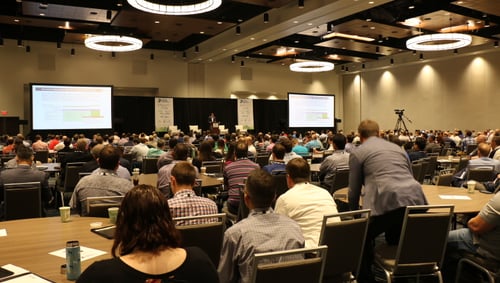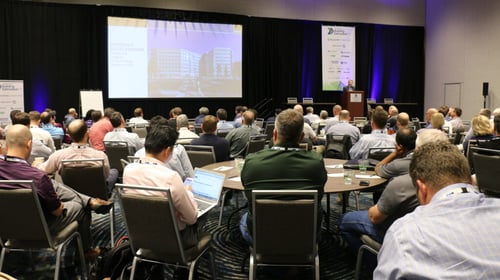How Can We Fix Preconstruction Problems?
Born from the industry and serving the industry, Beck Technology finds that collaboration and communication are making preconstruction and construction better. It’s made our products better and it has made our clients’ lives better.
Through hours and hours of conversations with estimators and general contractors, we’ve pinpointed the exact challenges and pitfalls of preconstruction felt across the board.
One of the most effective means of collaboration we have found is through the active role we’ve played in the annual Advancing Preconstruction (Advancing Building Estimation) conference since 2017. Hosting panel discussions with our industry partners have generated solutions to common problems found in preconstruction—especially through embracing the innovative technologies developed specifically for preconstruction teams.
Looking back on our 2018 half-day workshop, 250 of our preconstruction peers gathered to discuss four areas affecting preconstruction departments:
- Technology
- Talent acquisition and retention
- Predicting construction costs
- The future of preconstruction
Speakers included Matt Hammer of Haselden Construction, Matt Verst of Messer Construction, Jeff Ratcliff of The Beck Group, and Andy Leek of PARIC Corporation.
Technology’s Role in Preconstruction
Preconstruction teams recognize working in silos negatively affects the overall outcome of an estimate. There is a cultural shift happening to embrace and learn new technology that allows preconstruction teams to tie estimates to models. Gone is the “Where’s Waldo” effect. Teams no longer need to stare at drawings to see what has changed.
Preconstruction software streamlines processes and allows owners to get involved in the earlier stages of a project. Preconstruction teams can provide valuable information to help make better project decisions. Even though getting owners involved early may lead to giving a preliminary price and more questions, having a visual way to display the numbers makes owners excited about the project.
With all these “shiny new toys” on the market, it is vitally important to spend time researching not only the software but the company behind the software. To make sure your preconstruction team has the right tool, ask “Why is this technology important to my company?” Being able to create an internal team interested in technology to manage your software evaluations is key to choosing the right one.
 Join us at Advancing Preconstruction for collaboration on trends in preconstruction and solutions to common problems.
Join us at Advancing Preconstruction for collaboration on trends in preconstruction and solutions to common problems.Talent Acquisition and Retention
Most companies are realizing that cultural fit is a better indicator of a good employee rather than hiring for skill alone. In a straw poll of the room, 90% of attendees said they hire based on culture fit.
Haselden’s staged approach to hiring (salaried staff):
- Screening call from HR to determine their skill level, speak a little about the company, ask about salary requirements.
- Depending on the role, personality testing scores the candidate against the company’s cultural values.
- Screening call or in-person interview with the candidate’s prospective manager to determine technical capabilities and experience.
- “Discovery Day” with people who would potentially work with the candidate, but also people who may not have day-to-day interactions with them. This interview is about interpersonal interaction and allows the candidate to learn more about the company culture.
- After Discovery Day, HR will lead a round table to discuss the candidate and provide a final recommendation of an offer to the hiring manager.
Work-life balance is becoming more important than salary and title to seasoned professionals. Some attendees noted that they have left companies for a better quality of life and took a pay cut to do so. With the growing need for talent in the construction industry, having a flexible work schedule and an office environment that is appealing to work in all resonate with potential new hires. We are seeing a shift in the employee’s primary motivation for keeping a job move from compensation and benefits towards the emotional rewards that a job can provide.
Predicting Construction Costs
In 2018, we could have never predicted how much construction costs would fluctuate in just a few years. It is so much more of a challenge now than it was then; however, gathering cost history data has always been a real challenge.
Cost history is not as simple as cost per square foot. It is the metrics driving those costs. It is being able to analyze as-built data and then utilize that information to predict construction costs. Even then it goes beyond estimating data and looks at company data. The overarching goal of cost history is to provide unified information from the company regardless of location and/or market.
When people leave one project and get on another, they are already two weeks behind on the new project. In this fast-paced industry being able to have the time necessary to gather historical information is not always possible. Some companies tie this effort to bonuses for operations staff so there is more incentive to get the data gathered as soon as possible.
 Join Beck Technology during Advancing Preconstruction on Monday, August 30 at 9 a.m. and Tuesday, August 31 at 2:30 p.m.
Join Beck Technology during Advancing Preconstruction on Monday, August 30 at 9 a.m. and Tuesday, August 31 at 2:30 p.m.What Does Preconstruction Look Like in 2028?
Project deliveries will become more collaborative so an influx of integrated projects, as well as target value design, will be more rampant. However, for this to come to fruition, the liability of projects (legal terms) will need to be ironed out to let this collaboration happen.
The multitude of file formats will converge to a few allowing for ease of access from multiple platforms. This will decrease the drudgery associated with pre-construction as systems become more standardized. The reduction of the effort to collate data will allow pre-construction teams more time to analyze the data and add additional value to projects.
Pre-fabrication will continue to increase on project sites. While this can reduce project waste it also comes with the need to manage the change from architects to pre-construction to subcontractors to field crews. This change management will also drive cross-training among disciplines to better understand motivators and create a collaborative project environment.















